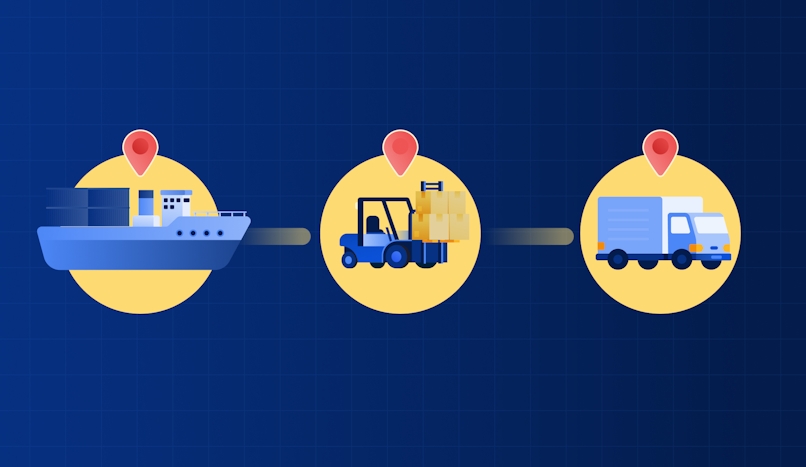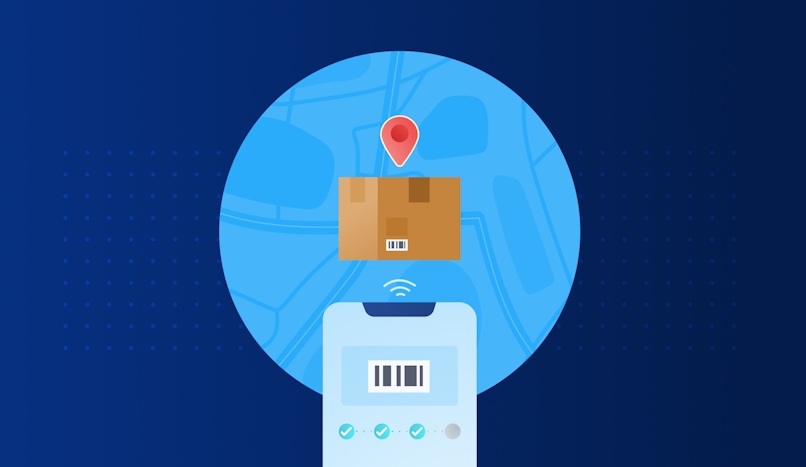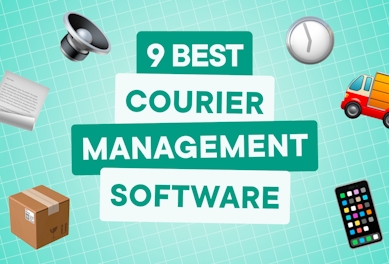What Is Asset Tracking and How Does It Work?
Discover the basics of asset tracking and how it can streamline your business operations. Learn the benefits and tools for effective management.

Easily track your drivers and assets out for delivery with Circuit for Teams.
Key takeaways:
- To implement asset tracking in your business, identify your needs, choose the right tech, create policies and processes, train employees, test and roll out the system, and regularly monitor and evaluate its performance.
- Asset tracking comes with challenges like data accuracy, maintenance, and security and privacy concerns. To overcome these challenges, establish clear procedures, proper system maintenance, and enforce strong security measures.
- For businesses looking for a vehicle and driver tracking solution, Circuit for Teams offers real-time tracking, route optimization and efficient driver management.
Asset tracking is a critical aspect of supply chain management that allows your business to monitor and manage your assets’ location, movement, and other related data.
Keeping track of digital and physical assets as your business grows becomes increasingly challenging.
And without a reliable asset management solution, you might experience operational inefficiencies, security risks, and financial losses.
By using asset-tracking solutions, your business can improve its inventory management, enhance productivity, reduce costs, and avoid losses.
In this article, we’ll explain what asset tracking is, the benefits of asset tracking, the types of assets to track, and real-time asset tracking methods you can use in your business operations.
Last, we’ll walk you through how to use Circuit for Teams as an asset-tracking tool for delivery drivers to help scale your growing business.
What is asset tracking?
Asset tracking is monitoring and managing a company’s physical assets throughout its life cycle — from acquisition to disposal.
You can do this by equipping assets with a GPS tracking system, a barcode scanner, or radio frequency identification (RFID).
Effective asset tracking allows your company to determine pricing accurately, monitor asset utilization, and conduct audits.
Tracking your assets is essential because they give value and are crucial for your daily business operations.
Assets are a broad term that may include inventory but also extend to other physical items like equipment, vehicles, machinery, and tools your business uses to operate.
For example, companies in the transportation industry may use asset tracking devices to monitor the location and movement of their vehicles to guarantee timely deliveries and improve customer service.
Retailers can track their inventory levels, including where items are in the store and which items are selling faster.
In the manufacturing industry, asset tracking can help monitor equipment performance and maintenance schedules.
It can even help automate reminders for preventative maintenance to avoid costly breakdowns or repairs.
Let’s consider the needs of a growing business.
As a business scales, its existing asset-tracking solutions may no longer meet its needs.
The increased number of assets, complexity of operations, and demand for real-time data make it crucial to adopt a more robust system.
Take, for example, a thriving logistics company that initially relied on spreadsheets and manual processes to track its team of delivery trucks.
As the business grows and gets more vehicles, manual tracking methods could lead to errors.
The need for real-time data on vehicle locations, maintenance schedules, and fuel consumption becomes paramount for smooth operations and optimal customer service.
By implementing an advanced GPS-based asset tracking system, the logistics company can:
- Monitor the real-time location and status of all vehicles, improving dispatch efficiency and supporting timely deliveries.
- Automatically create maintenance reminders based on mileage or usage, minimizing the risk of unexpected breakdowns or costly repairs.
- Analyze fuel consumption data to optimize routes and identify opportunities for cost savings.
Some other asset tracking methods include QR codes, barcodes, and cloud-based asset management software.
For example, by scanning barcodes, the healthcare industry logs assets like medication and medical equipment in an online computer system.
We’ll explore the different methods of asset tracking later in this article.
Examples of asset tracking
Here are some different examples and use cases:
- Supply chain management. You can use asset tracking to monitor the location and movement of goods and equipment throughout the supply chain. This can help optimize logistics, reduce shipping costs, and improve delivery times.
- Driver management. Asset tracking is essential if you have a company that owns and operates a team of vehicles. It allows you to monitor the location and movement of your vehicles in real time, making sure you have timely deliveries, improving customer service, and reducing fuel consumption.
- Manufacturing. You can use asset tracking to monitor the performance and maintenance of equipment in the manufacturing process. This can help optimize their production, reduce downtime, and improve efficiency.
- Healthcare. You can also use asset tracking to monitor the location and availability of medical equipment, such as hospital beds, wheelchairs, and infusion pumps. Equipment tracking can help hospitals and clinics improve patient care, reduce equipment loss, and optimize resource utilization.
- IT asset management. You can use asset tracking to monitor the location and use of IT assets, like computers, servers, and networking equipment. This can help you optimize your IT resources and improve security.
The benefits of asset tracking
We go over some of the main benefits of asset tracking.
Improved inventory management
Asset tracking can help businesses with inventory management because they can monitor the location and quantity of inventory in real time.
This can help prevent backorders because you can get notifications when inventory levels are running low and you need to restock.
You can also integrate asset tracking software solutions with other business systems — such as enterprise resource planning (ERP) or warehouse management systems (WMS) — to automate inventory management workflows and streamline operations.
ERP is a software system that helps your business manage and integrate various aspects of operations like inventory, accounting, and human resources.
On the other hand, WMS is a software system designed to manage your warehouse operations, including inventory tracking, order processing, and shipping.
By using asset tracking to optimize inventory management and integrating it with other business systems like ERP and WMS, your business can reduce inventory carrying costs, improve order fulfillment times, and increase customer satisfaction.
Increased productivity
Asset tracking can help increase productivity in the supply chain by helping your business monitor and optimize the use of your assets.
If you want your business to be efficient and avoid operational bottlenecks, you need to know where things are when needed.
Asset tracking lets you know where your assets, like vehicles or machinery, are at all times so you can get to work without wasting time searching for what you need.
For example, a logistics company can use asset tracking to monitor the location and movement of its delivery vehicles and use route optimization to reduce travel time and fuel consumption.
Currently, the average delivery driver makes around 150 to 200 stops each day.
If you’re handling the higher end of stops, route optimization features can save nearly two hours per day, leading to increased efficiency even in a well-organized system.
And by eliminating unnecessary miles, drivers save more money on fuel costs, averaging a savings of $0.15 cents per mile.
Fewer miles driven mean more savings for your team.
You can make informed decisions to improve delivery times and reduce costs by using real-time data on vehicle location and traffic conditions.
Reduced downtime
Lost and wasted time isn’t good for business.
Asset tracking can help your business reduce downtime by helping you remember to schedule preventive maintenance tasks and perform repairs before a breakdown.
This can help minimize equipment downtime and improve asset reliability, increasing productivity.
A computerized maintenance management system (CMMS) is a software-based solution to help your business manage maintenance operations more effectively.
It’s a great tool for asset management, allowing you to track and schedule maintenance tasks, monitor equipment performance and maintenance needs, and optimize resource utilization to reduce downtime and repair costs.
For example, a manufacturing company can use a CMMS to track the maintenance needs of its production equipment, schedule preventive maintenance tasks, and create work orders for repairs — saving time and keeping the business on track.
If you own a transportation company, you can use a CMMS to track the maintenance needs of your vehicles, schedule oil changes and tire rotations, and monitor fuel usage.
Cost reduction
Asset tracking can help your business save money by tracking the location and usage of assets.
This makes it easy to identify which assets your company doesn’t use as much and make decisions based on this information.
For example, a construction company could track equipment and realize they have several unused backhoes.
With that info, they can decide to sell those backhoes and use the money to purchase equipment that’ll be more useful to them.
This reduces the costs of maintaining and storing unused equipment.
Enhanced security and loss prevention

Asset tracking can help your business prevent theft or unauthorized use of assets by monitoring their location and movement in real time using GPS asset tracking technology, geofencing, or vehicle tracking solutions.
By tracking the location of your assets, you’ll know when an asset moves outside authorized areas.
One way to do this is through geofencing, like creating a virtual boundary around a specific area, such as a warehouse or construction site.
Using geofencing, you can get real-time alerts on your mobile device when an asset crosses the boundary — so you can take appropriate action to prevent theft or loss.
For example, a delivery company can use geofencing to make sure their trucks only work within specific routes or designated areas.
If a truck leaves the designated route or area, the system sends an alert to the manager’s mobile app or device, allowing them to prevent theft or misuse quickly.
Types of assets to track
Here are the different types of assets your company can track:
Fixed assets
Fixed assets are stationary and not easily moved. These include buildings, land, and heavy equipment like generators, industrial machines, and specialized tools.
Tracking these assets makes sure they’re in the right place and used properly.
This can be particularly important if your business has many fixed assets spread across different locations like warehouses or construction sites.
Mobile assets

Unlike fixed assets, mobile assets are frequently moved or taken off-site. Examples include vehicles, trailers, and shipping containers.
These assets, such as transportation, logistics, and delivery services, are common in vehicle operations.
For example, a logistics company can track its trailers to make sure they’re used efficiently, reduce the risk of theft or unauthorized use, and optimize its logistics operations so the trailers are available when and where they’re needed.
IT assets
IT assets are related to technology, such as computers, laptops, servers, and networking equipment.
These assets are critical to many businesses because they’re used to store and manage important data and information.
Knowing the location of IT assets, such as computers, drives, and other equipment, is crucial for facility management and security.
Losing these assets can lead to serious security risks and data breaches.
For example, a lost or stolen laptop may contain sensitive client data, trade secrets, or financial information.
If this information falls into the wrong hands, it can lead to financial losses, reputational damage, and legal liabilities.
Similarly, if a hard drive containing sensitive data is misplaced or stolen, it can result in a data breach, which can have serious consequences for a business.
People and personnel
Asset tracking isn’t just for computers and equipment — some systems can also track people, like employees or contractors.
This is especially helpful for companies with workers in risky or remote spots, like construction sites or oil fields.
By tracking the location of personnel, businesses can keep workers safe and respond quickly in an emergency.
This can include identifying employees’ locations in real time and using this information to direct emergency responders to their locations.
Tracking personnel can help businesses optimize workforce management by identifying which employees are under or overused.
One thing to keep in mind when tracking personnel is to balance the benefits of tracking personnel with employee privacy concerns.
Businesses should make sure their tracking systems comply with relevant privacy laws and regulations and that employees are informed and consent to the tracking.
Asset tracking methods
We explain a few methods for asset tracking.
Barcode scanning

One way to track assets is with barcode scanning.
This involves putting a special barcode label on each item and using a handheld or fixed barcode scanner to record where it is or is going.
With the help of scanning software on various apps, your business can manage and update the inventory log of these assets from a mobile device.
All authorized employees can access this electronic system, making tracking the movement and location of assets easier.
Asset tracking software is particularly helpful for companies with multiple offices or employees working remotely.
Plus, it can help with things like calculating depreciation or keeping track of on-site inventory.
RFID technology
RFID technology involves attaching a small device called an RFID tag to each asset, broadcasting its location.
RFID readers can capture the asset’s location and movement data in real time, giving accurate and up-to-date information.
This method is particularly useful for companies needing precise tracking of assets and wanting to minimize errors in their tracking systems.
You’ll need a handheld scanner to read the RFID tags, so it’s important to determine the number of scanners you need before going with this method.
GPS tracking
GPS tracking is an asset tracking method that uses GPS technology to monitor the location and movement of mobile assets in real time.
This is particularly useful for businesses with a team of vehicles or shipping containers that need tracking.
GPS tracking devices can be mobile or hardwired into equipment and communicate through cellular networks or satellites.
The system can also set geofences and alerts to notify business owners when an asset has gone beyond the designated area.
The benefit of GPS tracking is that it simplifies driver management and gives businesses an easy-to-use dashboard to monitor their assets as they move throughout the workday.
Bluetooth beacons
Bluetooth beacons are small devices attached to assets to transmit a signal.
These beacons can capture location and movement data in real time when paired with a smartphone or tablet.
This method is useful for indoor tracking or tracking assets near each other, such as in a warehouse or retail store.
Bluetooth beacons are affordable and easy to use, making them popular for asset tracking in smaller operations.
However, they have limitations in terms of range and may not be suitable for tracking larger assets or assets in outdoor environments.
Asset tracking software
Asset tracking software is a specialized tool that helps businesses manage their assets by tracking inventory, maintenance schedules, and other asset-related data.
This software streamlines tracking physical assets, eliminating the need for manual spreadsheets or hard copies.
This software is particularly useful for high-tech tracking methods, such as GPS-based systems, which give visualization tools for tracking large assets like trucks and improving security measures with geofencing technology.
How to implement asset tracking into your business
We offer seven steps to getting started if you’re interested in implementing asset tracking in your business.
1. Determine your business needs
Start by asking yourself what assets you need to track. How do you capture the information, and what are your desired outcomes of the asset tracking system?
Assessing your business needs can help you figure out what type of asset-tracking system will be most effective for your organization.
For example, a construction company may need to track heavy equipment, vehicles, and tools. They may want to capture location, maintenance schedules, and usage history.
They might want to reduce equipment loss and theft, improve maintenance scheduling, and optimize asset utilization.
You can determine the most appropriate tracking methods and software by identifying these needs.
2. Pick the right technology and software
Choose the tracking methods and software that best meet the needs and requirements of your business.
Consider cost, ease of use, and compatibility with existing systems.
Various asset tracking solutions are available, ranging from simple barcode scanning to advanced GPS tracking systems.
3. Create asset tracking policies and processes
Develop clear and comprehensive policies and processes for asset tracking, including guidelines for asset labeling, data capture, and reporting.
Your policies should outline how your company tracks assets and who maintains the asset tracking system.
An example of a policy and process for asset tracking could be:
- All assets have a unique identifier barcode label with the asset name and number.
- All employees are responsible for scanning the asset barcode when checking assets in and out of the inventory.
- Any discrepancies or missing assets are reported immediately to the asset tracking system administrator.
- The asset tracking system administrator regularly runs reports on asset usage and maintenance schedules.
- The asset tracking system administrator approves any changes or updates to asset information before being made in the system.
4. Train your employees
Training employees on using the asset tracking system is key to its success.
Employees need to understand how to use the technology and software to track assets accurately and follow the policies and processes for asset tracking.
It’s important to give comprehensive training to all employees using the system, including any new hires.
You can train through various methods, such as in-person training sessions, online training modules, or user manuals.
The training should also be ongoing to make sure employees stay updated with system changes or updates.
5. Test the system
Before implementing the asset tracking system, conduct thorough testing to make sure it works as intended and captures accurate metrics.
The key is to identify any issues or areas that need improvement before you launch the system to avoid potential issues.
For example, suppose your company wants to use a GPS-based asset tracking system for vehicles.
In that case, you might conduct testing by installing GPS devices in a few vehicles and monitoring the accuracy of the location data.
This way, you can catch errors before you roll it out to all your vehicles.
You can also simulate various scenarios, such as lost or stolen vehicles, to check that the system can give the necessary data to recover assets.
6. Roll out the system
Once you’ve tested the system and it’s ready to use, roll it out across the business and begin capturing data.
You should do this in a phased approach to allow for any necessary adjustments and to make a smooth transition.
7. Monitor and evaluate the system
Regularly monitoring and evaluating the asset tracking system makes sure your system remains effective and meets the changing needs of your business.
One way to do this is by setting up performance metrics and regularly reviewing them to identify areas where the system falls short.
This could include metrics like asset utilization, maintenance costs, or inventory accuracy.
Based on these metrics, you can make adjustments to improve the system’s performance, such as updating policies and processes, giving additional employee training, or investing in new technology.
Additionally, regularly gathering feedback from employees who use the system can help identify areas for improvement and keep the system user-friendly and effective.
Challenges of asset tracking
Asset tracking has many benefits. But it also comes with some challenges. Here are some challenges you should be aware of.
Data accuracy and consistency
One of the key challenges of asset tracking is data accuracy and consistency.
Asset tracking systems rely heavily on accurate data capture and reporting to give useful insights and inform decision-making.
If someone enters data incorrectly or doesn’t update it in a timely manner, the system may give inaccurate information, leading to poor decision-making.
It’s important to establish clear procedures for data capture and make sure your employees know how to enter data accurately and consistently.
Everyone should be clear on their responsibilities in keeping the system working well.
Maintenance and updates
Asset tracking systems need ongoing maintenance and updates to keep them functioning properly and giving accurate data.
This includes updating software, replacing outdated or malfunctioning equipment, and making sure the system works with other systems and technologies in your business.
Maintaining and updating asset tracking systems can be time-consuming and costly, but it’s essential to keep your systems running smoothly and effectively.
Security and privacy concerns
Asset tracking systems may capture sensitive data, such as the location of high-value assets or personnel movements.
This can be a security risk if someone compromises the system.
It’s important to be sure your asset tracking systems have strong security measures to prevent unauthorized access and that you encrypt and store sensitive data securely.
Additionally, you’ll want to comply with relevant privacy laws and regulations and inform employees so they can consent to the tracking.
Track your vehicles and drivers with Circuit for Teams
Asset tracking can bring many benefits to your business, such as increased productivity, cost reduction, and enhanced security.
However, there are challenges, such as data accuracy, maintenance, and privacy concerns.
It’s important to determine your business needs and think about the different asset tracking methods before deciding if it’s right for your organization.
If you’re looking for a vehicle and driver tracking solution, consider Circuit for Teams.
Circuit allows you to track your drivers and vehicles in real time, optimize routes, and manage your drivers more efficiently.
With Circuit for Teams, you can address the pain points of manual processes and outdated solutions as your business grows.
Here’s how Circuit can help your delivery team:
- Cost reduction. Circuit for Teams helps reduce costs by optimizing routes for fuel efficiency, minimizing vehicle wear and tear, and reducing delivery times. This leads to savings on fuel, maintenance, and labor costs.
- Ease of use, integration, and ability to scale. Circuit for Teams is designed to be user-friendly, making it easy for your employees to learn and adopt the system. The software integrates with your existing systems and workflows, streamlining the transition to a digital solution. As your business grows, Circuit can scale with you, allowing you to manage an increasing number of drivers and vehicles without sacrificing efficiency or performance.
- Speed of adoption. One key advantage of Circuit for Teams is its rapid implementation process. Your business can quickly start benefiting from the platform’s features without a lengthy setup or learning curve. You don’t even have to waste time talking to sales — just get started with a free trial right away.
With Circuit for Teams, you know where your vehicles, drivers, and packages are throughout the process, and your customers have automated delivery tracking information like an estimated time of arrival (ETA), the delivery status, and proof of delivery information.
Circuit for Teams also makes it easy to change live routes and notify drivers of changes automatically. Try Circuit free now.




